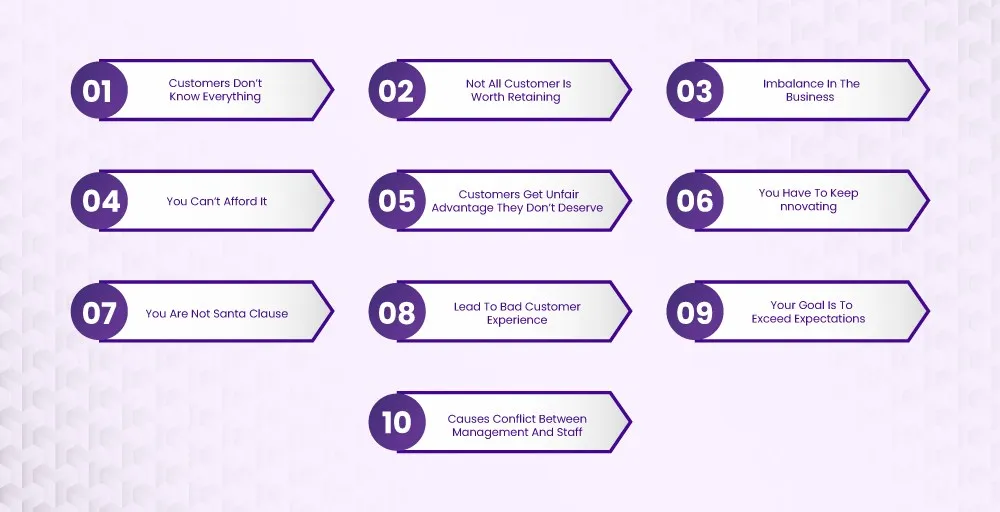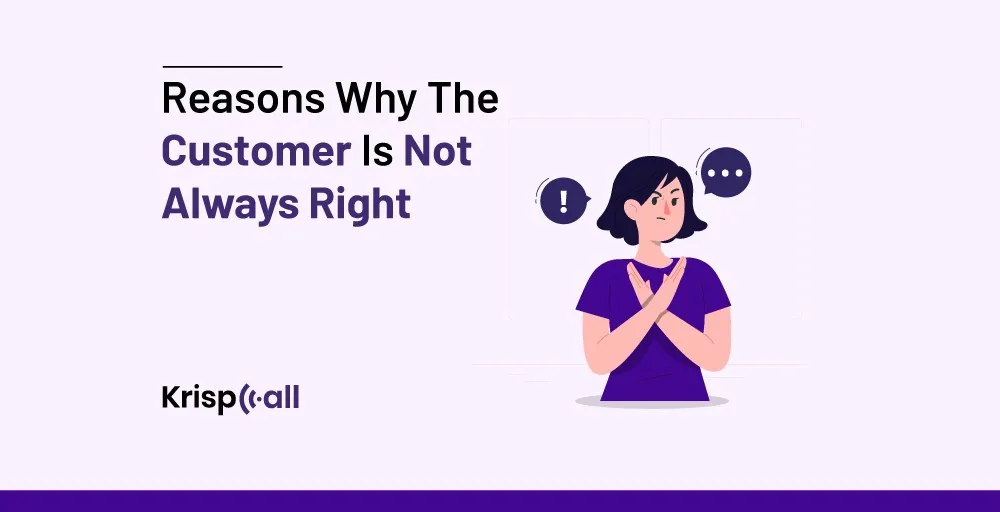Imagine you are in the midst of a busy workday, juggling multiple tasks, when an 😤angry customer demands an unreasonable refund🙄.
At that moment, a “Customer is always right” mentality might arise, but granting such a request could set a dangerous practice⚠️ for your business. You know what? “This principle is right but not always practical.”
Apparently, customers are important as they drive revenue, ensure job security, and spread the word about your business. However, following such principles can lead to unsustainable business practices and even a decline in overall service quality.
In this blog, we will discuss 10 reasons why the customer is not always right and the seven best strategies for addressing situations when the customer is not always right.
🔑KEY HIGHLIGHTS
- The “customer is always right” mindset keeps your business imbalances and financial fluctuation.
- The top reasons why customers are not always right are that they don’t know everything, they get unfair advantages, and they create conflict between management and staff.
- Sometimes, you have to step back or step in to tell customers that their abusive behavior is not acceptable in any way just because they are your customers.
- Stay calm, acknowledge and validate customers, focus on their issues, and offer alternatives to address situations when the customer is not always right.
Top 10 Reasons Why The Customer Is Not Always Right
Although there is the idea customers behold that the “customer is always right,” it cannot always be true. Here, we present the top 10 reasons why “the customer is not always right.” This assists you in understanding how their ideology of being always right can be an issue in customer service.

1. Customers Don’t Know Everything
Although you may expect customers to read instruction manuals, warranties, and return policies as a business owner, this does not happen in the real world. Customers make unrealistic demands that result from their own mistakes of not comprehending your services. They even give feedback without completely understanding your product or service.
Moreover, the customer is not always right because you know your business better than they do. Therefore, you don’t have to take every feedback as long as you know your policies are right.
2. Not All Customer Is Worth Retaining
Every customer is not worth retaining because of their negative impact on the business. Even though customers are important, they might not be worth keeping as clients because of their excessive demands, unreasonable expectations, and abusive behavior. Such customers may not contribute to the company’s long-term growth.
Consequently, competitors might easily sway them, and their retention might not be sustainable for your business’s long-term goal. Therefore, you should focus on retaining cooperative and committed customers to your brand since they can contribute to your business’s long-term success.
3. Imbalance In The Business
Customers are not always right because they might lead to an imbalance in the business in many ways. Also, Repeatedly fulfilling customer needs may lead to overwork and underappreciation among employees. This will lead to call center burnout and high turnover rates, affecting the business’s overall performance.
Suppose a business caters to customer demands without considering the long-term implications. In that case, a business may have trouble maintaining its operations or providing quality products or services, resulting in an unsustainable business model.
4. You Can’t Afford It
The phrase “the customer is always right” is mostly used as an excuse for businesses to fulfill every customer’s need, regardless of the financial implications. Nevertheless, this ideology can cause financial instability and poor business decisions.
For instance, if a customer asks for a custom product that requires significant resources and time but the business cannot afford it, businesses should not feel pressured to provide it. Instead, they should explain the situation and give the customer an alternative solution.
5. Customers Get Unfair Advantage They Don’t Deserve
The customer is not always right since they get an unfair advantage they dont deserve. When customers start thinking that businesses take them as always the right person, they will start having unreasonable expectations. Also, customers are not supposed to get the reward when they are rude.
Giving them the upper hand just because they think they are always right is unfair to employees and customers. They will feel that they can say or do anything without any accountability, which is not fair to anyone.
6. You Have To Keep Innovating
The customer is not always right because they might not understand how much hard work businesses do to give the results to customers that make them happy. Despite anything else, businesses must innovate to find creative solutions to meet customers’ expectations while staying financially sustainable.
If a customer asks for a feature that is not feasible with the current technology, the business should calmly explain the scenario and provide alternative solutions. This approach shows that the business is committed to meeting customer needs while staying realistic about what can be achieved and what cannot.
7. You Are Not Santa Clause
Having the mindset that “the customer is always right” will mislead you in your business. Businesses really don’t have to follow everything their customers want, even if that might not be a good thing to do in a business.
Business owners don’t have to waste their energy or finances on customers who are not ready to be reasonable. You, as a business owner, are not their Santa Clause. Instead, you should focus on helping fair and nice customers, fostering strong relationships with them. In this way, businesses use their resources wisely and don’t waste them on customers who don’t value brands.
8. Lead To Bad Customer Experience
When managers believe that the customer is always right, it can lead to bad customer service. Paulson says, “If you’ve got associates trying to move heaven and earth, it can take them away from other customer interactions that would be more meaningful.”
Simply put, when a customer service representative spends time trying to align unrealistic customer expectations, there is no time left to dedicate to the rest of the great customers, leading to a bad customer service experience for them.
9. Your Goal Is To Exceed Expectations
Sometimes, Customers don’t understand how far you can go to make them happy and satisfied. That’s why we say that customers are not always right. Most of the time, policies that customers are unaware of are made to help them and improve their experience. But who is going to really help them with that? It should be the customers themselves.
Furthermore, customers don’t even have an idea of the products and services that are available just for them. Thus, to create sustainability, you should aim to exceed expectations but not meet them for customers’ unnecessary reasons.
10. Causes Conflict Between Management And Staff
The mentality that says “the customer is always right” causes conflict between management and staff. When customers make unrealistic demands, employees are forced to meet those expectations.
Likewise, conflict arises when management and staff have different expectations about how to handle customer interactions. When management emphasizes the significance of pleasing customers at all costs, staff might feel that this approach is unfair, leading to misunderstanding and tension. This results in poor customer experiences and high employee turnover.
Strategies For Addressing Situations When The Customer Isn’t Always Right
When you face challenging situations where you have to deal with difficult customers, you need to be professional, have a good combination of call center skills, know all about customer behavior, and prioritize effective communication to stop losing customers and clients.
Aside from that, you need to know a few strategies to address such situations. So what are those? Let’s look at the seven best strategies for addressing situations when the customer is never right.

1. Stay Calm And Composed
Maintaining a calm and composed demeanor when dealing with challenging customers is essential. This practice helps de-escalate the situation and prevents the problem from becoming more complicated.
By staying calm, you can think more clearly and reply more effectively, increasing the possibility of resolving the issue successfully. Moreover, you can create a more constructive dialogue and work towards a mutually beneficial solution.
2. Acknowledge And Validate
Acknowledging and validating customer concerns is the critical step in resolving the issue. This allows you to forge trust by showing that you genuinely try to acknowledge and validate their problem.
Similarly, understanding customers’ perspectives can create a more positive and collaborative atmosphere, ultimately increasing the chances of successfully resolving the issue.
3. Focus On The Issue, Not The Person
When addressing the issue, you must focus on the specific issue rather than making personal attacks or criticisms of the customer. This way, you can maintain a professional tone and prevent the situation from becoming personal.
Furthermore, when you focus on a particular issue, you can work together to find the solution that meets customers’ needs and expectations, benefiting both parties and achieving success in the business.
4. Provide Clear And Concise Information
While addressing situations when the customer is not always right, you have to provide clear and concise information about the issue to the customer. This helps to build trust and ensure the customer is informed throughout the process.
Additionally, You can maintain a positive relationship by staying transparent and giving regular updates. This approach definitely demonstrates your commitment to customer satisfaction in difficult circumstances.
5. Offer Solutions And Alternatives
You can address the issue successfully when the customer is never right by offering solutions and alternatives to the customer. You can show that you are committed to finding a mutually beneficial solution and willing to work together to achieve the solution.
Showing different options or alternatives can increase the chances of a successful solution. This helps build trust and gives the customer a sense of control and agency, increasing customer satisfaction with a good outcome.
6. Follow Up And Follow Through
You must follow up with the customer after resolving the issue to maintain a positive relationship with your customer. You can ensure that the issue is completely resolved and that your customer is satisfied.
By checking in with the customer, you can identify any remaining issues and address them promptly. This approach can be very helpful in demonstrating your loyalty to customer satisfaction.
7. The Customer If They Are Wrong
Sometimes when dealing with customers who are not always right, you must gently tell them they are wrong. For instance, a customer might buy an item from a different store but ask you to return it to your store.
In such a situation, you must employ a customer-centric culture to let the customer know they are mistaken. You must do this in a kind and respectful way without shaming them or making them feel bad about their mistake.
Even after following every strategy for dealing with challenging customers who think they are always right, if they don’t stop their verbal or abusive actions, you need to step in and inform them that such things are not acceptable.
Wrapping Up
The customer is not always right because they might lack product knowledge, have unreasonable demands, and have the potential to create business imbalances and financial instability. Dealing with challenging customers can lead to unfair advantages, stifle innovation, and result in poor experiences for other customers while also creating conflict within your team.
However, by creating effective communication and setting clear boundaries, you can balance customer satisfaction with long-term business success, guaranteeing fair and sustainable practices for everyone, whether customers or employees.😊
FAQs
What does it mean when we say “the customer is not always right”?
When we say “the customer is not always right,” it means that they might not completely understand a product or service and make unrealistic demands.
Is the customer always right?
“The customer is not always right” means that while customer satisfaction is important, businesses should not always accommodate customer demands, especially when they are unreasonable, unfair, or detrimental to the company, employees, or other customers. It emphasizes the need for businesses to set boundaries, protect their integrity, and maintain a balance between meeting customer needs and ensuring sustainable operations.
How do you respond to “customers are always right”?
The way to respond that customers are always right is mentioned below:
- Thank your customer for bringing the issue to your attention, and apologize for any inconvenience.
- Calmly explain what happened and the reason why it happened.
- After that, provide a solution to their problem.
- Lastly, ensure you follow up with the customer to guarantee that the issue has been resolved to their satisfaction.
How do you manage challenging customers?
You can manage challenging customers by following the below instructions:
- Understand their perspective of particular issues and try to know where they arise.
- Empathize listening to them and attempt to resolve the issue.
- If the customer is not being reasonable, try to defuse the situation using your training.
What are some best practices for handling customer complaints or disputes?
Some of the best practices for handling customer complaints or disputes are given below:
- Carefully try listening to their complaint to understand their perspective.
- Ask for an apology for the inconvenience they have experienced.
- Provide a solution that will make them happy and satisfied.
Why is it important for businesses to say no to customers?
It is important for businesses to sometimes say no to customers because customers can be unreasonable and make unrealistic demands impossible to meet.





